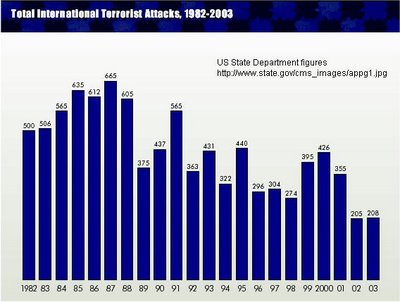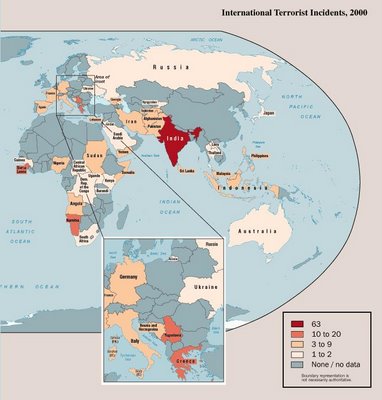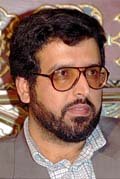What is the threat of militant Islam?
In the days of conquest that saw the advent of regimes like the Caliphate and the Byzantine Empire, violent conflicts between adversaries were limited to contests fought in real time against visible foes.
The United States military has been traditionally developed around fighting one or a few sovereign nations deploying uniformed armies on known battlefields, usually to defend a specific territory. The technology of war was changed dramatically since that era.
Militant Islam represents a serious threat to American culture and public safety in that they have adopted a strategy of using guerilla tactics (remotely detonated explosives) and martyrdom to kill the largest possible groups of people.
Modern anti-terrorism strategies and rules of engagement can only limit - not defeat - militant Islamic terrorism.
Globalization of terrorism
Unlike Irish terrorism of the 1980's or similar nationalist movements of decades past, Islamic terrorism has spread beyond the borders of the Islamic states to nearly every continent.
Global communications technology has scattered much of the control of militant Islamic forces away from Usama Bin Laden and Al Qaeda, and splintered the movement into many cells that are sympathetic to Bin Laden but operate autonomously. Militant Islamic forces covertly operate in America, Europe, Africa, the Middle East, and much of Indonesia.Madrasas
"Madrasas" are schools for Islamic children.
Some madrasas are run by militant groups who incorporate hatred ideology against all western culture, but particularly that of America, nurturing a steadily increasing pool of willing militant Islamic martyrs, which represents a very long-term threat to global peace and stability.Foes often indistinguishable from friends
Ramadan ShallahEnemies used to be distinguisahble by their uniforms.
The man in this photo is not a member of any local PTA. Ramadan Shallah is one of the original founding members of the "Palestinian Islamic Jihad." See alternate photos of him and other major militant Islamic terrorists at the FBI's Most Wanted Terrorists listing: http://www.fbi.gov/wanted/terrorists/fugitives.htmDespite that many moderate Muslims and American politicians claim that militant Islam represents a small minority of the Islamic community, there seems to be overwhelming public support in Islamic states for militant Islam. Consider how relatively easy it is to see news footage of militant Muslims dancing in dusty streets, chanting, "Death to America," brandishing automatic weapons. These demonstrations typically celebrate some recent act of violence, such as the destruction of the World Trade Center or the headless, burning corpse of a construction worker whose sin against Islam was working for an American company to improve Iraq's infrastructure.
Meanwhile, there is rarely any public demonstrations by any Muslims supporting peaceful coexistence with non-Muslims. Even in the United States it is almost unheard of to see any public demonstrations by Muslims who condemn militant Islamic terrorism, despite a fatwa, or Islamic religious ruling, against terrorism and extremism issued by the Fiqh Council of North America (FCNA) and endorsed by the Council on American-Islamic Relations and more than 120 U.S. Muslim groups, leaders and institutions.
Rapidly growing numbers
The largest Muslim population in the world is in Indonesia, with 88% of census respondents describing themselves as Muslim. Most are said to be moderate and peaceful, but militant Islamic groups in Indonesia persistently attempt to overthrow the government.According to the European Social Survey of 2003, Europe's Muslim population has tripled in the past 30 years, fueled by immigration from North Africa, Turkey, Pakistan, and Bangladesh. The largest Muslim population in western Europe is in France, where Muslims face high unemployment and often live in poor suburbs.
In 2005, the accidental death of two Muslim teenagers triggered weeks of rioting by young North African Muslim immigrants. The violence spread from a Paris suburb across the French countryside. Recent census figures show that 10% of the French population may be Muslim as of this writing.
Attacks growing in number and violence
Global terror attacks by militant Islamic forces have grown exponentially in recent years. Even if you don't count the assassination of Senator Robert Kennedy by a Jordanian Arab-Palestinian on June 5, 1968 as a militant Islamic attack, consider these other militant Islamic terrorist attacks on Americans listed here, just one per decade, as examples:November 4, 1979, in Tehran, Iran -
Fifty-two American citizens were taken hostage when militant Islamic students stormed the U.S. embassy in Tehran and kept hostage for 444 days until the day of Ronald Reagan's Presidential inauguration.October 23, 1983, in Beirut, Lebanon -
A truck loaded with a bomb crashed into the lobby of the U.S. Marines headquarters in Beirut, killing 241 soldiers and wounding 81. The attack was carried out by Hizballah with the help of Syrian intelligence and financed by Iran.February 26, 1993, New York, USA -
The World Trade Center in New York City was badly damaged when a car bomb planted by Islamic terrorists exploded in an underground garage. The bomb left 6 people dead and 1,000 injured. The men carrying out the attack were followers of Umar Abd al-Rahman, an Egyptian cleric who preached in the New York City area.October 12, 2000: In Aden, Yemen -
A small dingy carrying explosives rammed the destroyer U.S.S. Cole, killing 17 sailors and injuring 39 others. Several supporters of Usama Bin Laden were convicted. Some escaped jail in Yemeni on February 3, 2006 and remained at large as of this writing.




No comments:
Post a Comment